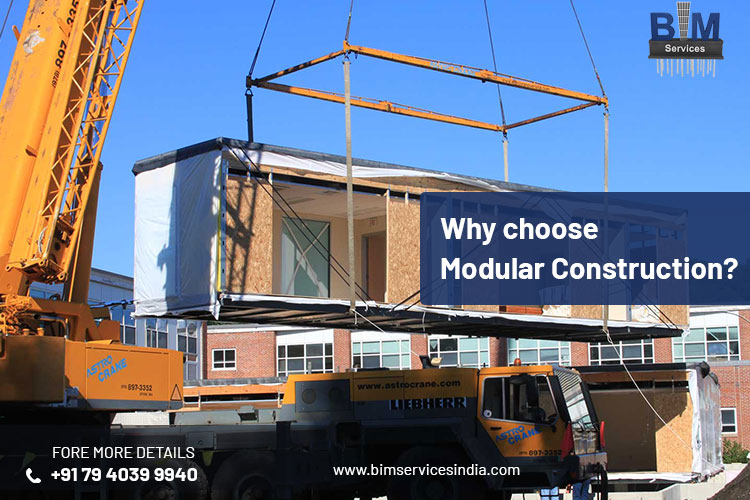Why choose Modular Construction?

The process of construction can be costly and time-consuming. There are a variety of factors which could cause delays like inadequate planning, too few personnel, weather conditions etc. Lengthy construction process could have some serious consequences on the budget of the entire project. It is here that Modular Construction could prove to be quite advantageous.
In the current article we talk about the importance of modular construction and why it could be particularly advantageous when used in association with BIM Services.
Table of Contents
What is Modular Construction:
Modular Construction is the method of construction wherein the building may it be an office, apartment or a business complex is constructed in an offsite climate-controlled location and is later assembled on-site. It ensures that the same codes and standards are applied in modular construction as it would in a traditional building. This method of construction increases the speed as well as provides better quality deliverables.
There are two types of modular construction. The first is volumetric modular construction wherein entire rooms or sections of rooms including walls, floors etc. are constructed in a warehouse and then transported onsite. Panelized construction is a process in which interior or exteriors wall panels are built offsite and then arranged on-site.
What are the advantages of Modular Construction?
Modular Construction Saves Time:
Modular construction allows for two different kinds of work to take place simultaneously. For instance, when the walls are being constructed in the factory location, site-work and foundations can be performed onsite. This allows the projects to be completed up to 30% -50% faster than the traditional construction method. Moreover, since the construction is completed inside a factory where the climatic conditions can be controlled there are no delays taking place due to weather conditions.
It is beneficial for the environment:
The modular construction generates less waste, there are fewer site disturbances and also allows for tighter construction all of which makes the design more sustainable. Modular Buildings can be disassembled whenever the building is no longer in use. The material can be used to create new parts or components. This reduces the need for using new raw materials and also generates less waste which needs to be disposed off. Moreover, modular construction creates less rumble, dust etc. which can generally be found onsite and improves the quality of the air.
It improves the quality:
Firstly, it maintains the same standards and codes that a regular building would have. In a factory controlled setting the high-level moisture is not being trapped in the construction which provides better quality buildings. With prefabrication the architects, engineers and designers have the liberty to try new designs and experiment with new materials.
Increases Safety:
Another problem that plagues the construction industry currently is the lack of skilled labour. In modular construction a lot of tasks can be done with machines which would have to be done manually in onsite conditions. Today even robots can take over come repetitive tasks. Moreover, for even workers there are less chances of accidents and liabilities that would concern them during onsite construction.
Better Modular Buildings and BIM
Modular Construction can be particularly beneficial when it is used in association with Building Information Modeling. Its enhanced visualization ensures that the materials or components which are prefabricated in the warehouse actually fit onsite. It allows to detect any interferences so that there are no clashes on-site. For instance: MEP BIM Services and Clash Detection can be used to ensure that the Pipe and duct which are prefabricated in the factory can easily fit when they are assembled onsite. BIM thus allows to reduce rework and save time, energy and resources. With BIM finally, it is also possible to calculate energy performance and identify better design alternatives which could lead to better, safer and environmentally sound buildings.
Conclusion:
Modular Construction provides better quality management and improves the completion time. When the construction industry is already looking for solutions to lack of skilled labors and ways to construct buildings faster, modular construction is perhaps the answer.